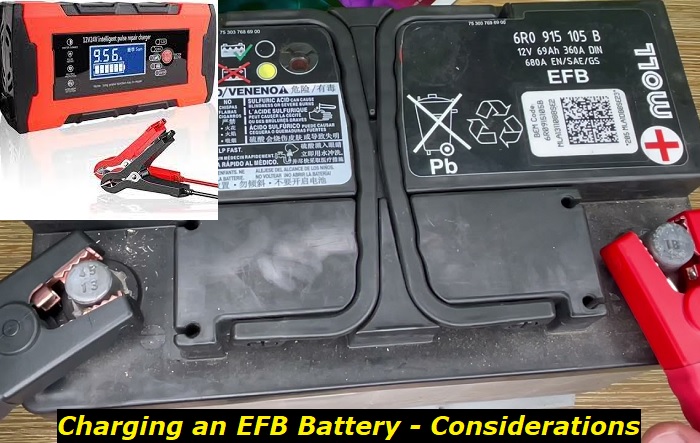Keep in mind that you can't use a normal charger for an EFB battery. It requires a special charger just like an Absorbed Glass Mat (AGM) battery does. The special charger helps to avoid overcharging.
Battery lifespan highlights
- Average lifespan:4-5 years for 12V,10years for Li-Ion
- Average price:$150 - $250 for 12V, $1,000-$4,500 for Li-Ion
- Reasons for death:deep discharge, constant drains, age
- Prevention:regular charging, good contacts
- Ways to fix:charging, replacement
- DIY repairs:possible

What Are EFB Batteries?
An enhanced flooded battery works in a similar way to how a lead-acid battery operates. But their technologies differ. The tech of an EFB is better, making it last longer with low maintenance.
EFBs incorporate the chemistry of gel batteries, but in an advanced way. This is to ensure their use in stop-start vehicles. These batteries experience quick charging and discharging cycles that regular flooded lead-acid batteries aren't made for.
You should seriously consider opting for an EFB battery if your present lead-acid battery is defective. It's a good alternative for start-stop vehicle owners who want batteries that possess larger capacities and can take deep discharges.
EFB Batteries Compared To Other Battery Types
Think of this section as a preliminary part to the one that states the pros and cons. I differentiated EFBs from other battery types using various important considerations. You'll also see the similarities between an EFB battery and an AGM battery.
1) Start-Stop Feature
Conventional batteries aren't well-compatible with the recent-year start-stop engine systems. And the merits of start-stop engine systems can't be overemphasized. They help to manage when your engine runs, thereby decreasing the use of fuel in heavy traffic.
Your engine will stop whenever you press the brake to halt the car. It will restart when you release your foot from the pedal. You won't have to worry about the fuel consumption rate, even if you break and accelerate a great number of times.
A conventional battery isn't built to endure such stress over a long time frame. It may experience failure after some months. But the reverse is the case for an EFB battery. It's strong enough for such ordeals.
Start-stop vehicle owners can also opt for AGM batteries, apart from EFBs. Although they're both different in terms of operation, electrical workings, and charging rate. I've elaborated further in subsequent subheadings.
2) Background
Firstly, let me start with a brief history of these batteries. EFBs were introduced to the market in 2008, while AGM batteries came way earlier. The latter was first launched for military operations in 1985.
EFB batteries were made to decrease emissions by lowering fuel usage. Although they aren't well-suited for some car models. The issue of emissions reduction has been given much attention in recent years. And this is largely due to concerns about environmental pollution all over the world.
Emissions control was what prompted the need for the increased production of (electric vehicles) EVs. Car battery shoppers can deal with the aspect of emission limits by getting EFBs.
It may be unnecessary to swap out your AGM battery for an EFB if the former is still in good condition after many years. Also, consider how well the AGM battery has been working for your car. Compatibility should be thought about in the sense that the vehicle's original battery is usually the best one for it.
You can swap out a flooded lead-acid battery for either of the two for better performance. But make sure to do proper research on which one is most fitting for your car.
What Is an AGM Battery?
An AGM battery is a type of deep-cycle battery that's sealed. It doesn't need any maintenance just like an EFB. AGM batteries have a similar operation to conventional batteries. They're different in the sense that they possess fiberglass mats between the negative and positive plates.
The electrolyte in an AGM battery passes through the mat in a regulated way without the risk of flooding. There'll be no leaking fluid in the event of the battery casing breaking. This battery type is prone to heating up too much because of the low amount of electrolyte it contains.
3) Charger Type
As stated earlier, EFBs and AGM batteries both use special chargers. An EFB charger typically features a built-in control unit that helps to avoid overcharging. This makes the charging process easier and safer.
Examine your battery's case for information about the recommended working conditions and optimal charging voltage. Meanwhile, take a look at the right way to charge EFBs below.
EFB Battery Merits and Disadvantages
This section will help you decide if buying an EFB battery is worth your money or not. But the pros obviously outweigh the cons by a huge gap. The merits below are what to expect when comparing EFBs vs. conventional types.
Merits
- Enhanced flooded batteries can generate a way higher starting current. Regular batteries may only be able to give you 300A. But you can expect 550A from an EFB.
- It has a longer lifespan in addition to its resistance to corrosion-resistance and being able to withstand the elements.
- It has a faster charging rate.
- EFB batteries work well during the rainy season or winter.
- They're a very good choice for entry-level vehicles, particularly because of their cheaper prices.
- You can store an EFB safely for two or more years. And you won't have to worry about it losing much storage capacity.
- This battery type has great compatibility with start-stop engine systems in terms of performance.
- It's tougher on rough roads. This is why they're very good for motorcycles, especially the off-road types.
Disadvantages
- Some vehicles are more compatible with AGM batteries than EFBs.
- EFB battery charging conditions are strict. This is because they can easily get overcharged. They can also sustain damage from a boiled electrolyte.
How To Charge EFB Batteries Correctly? (Rules)
Ensure that your car's battery stays in good health by charging it regularly or before it goes flat. The frequent jump-starting of a battery can affect its lifespan adversely. You can charge your EFB battery efficiently, thanks to its special charger. But you also have to know the charging rules for a proper process.
DIY EFB charging isn't as complicated as you think. One major rule is that voltage must not go over 14.4V. Another is to cease charging when the indicator reads 2.5A. See other charging rules/steps below
Step 1: Know the Charging Instructions
Ensure that you learn the working instructions on the charger and use it as directed for stop-start tech.
Step 2: Clean the Battery Terminals
You must do this before charging to eliminate dirt, grease, and corrosive materials. Cleaning the terminals also creates a clear and safe area for an effective connection.
Step 3: Disconnect the Battery
Some manufacturers recommend that the battery should be uninstalled from the vehicle. So read the owners' manual for charging instructions before you begin.
Step 4: Make the Charger Connections
The charger should be turned off before you link the red positive (+) lead with the battery's positive (+) terminal. It's important to do this before linking the black negative (-) lead to the battery's negative (-) terminal. Make sure the charger isn't close to the battery before turning it on. You can start the charging process after.
Step 5: Start Charging
Watch the charger for the voltage and amperage readings as described earlier. Put off the battery once satisfactory results have been attained.
Step 6: Disconnect the Charger
Proceed to unlink the negative lead followed by the positive lead. Re-install the battery if needed and your vehicle will be good to go.
Step 7: Get the Engine Back to Normal
You may have to perform an Idle relearn or reset if the battery was disconnected. A scan tool may be required instead, especially if the procedure fails. Some car models only need to be diagnosed with a scanner for error codes to be read and cleared. Then the engine can start functioning properly again.
An Idle relearn is carried out on many new-model vehicles that feature PCMs (powertrain control modules). This is because depriving your engine of its source of electrical power will delete the PCM's idle memory.
Conclusion
EFB batteries are always a good choice for vehicle owners, especially for start-stop vehicles. Buying one means giving yourself peace of mind when it comes to battery maintenance. This is in addition to the minimized risks of fluid, corrosion, and electrical issues.
It's noteworthy that nearly every vehicle being manufactured right now will either come with an EFB or an upgraded AGM battery. This is because of recent developments in start-stop engine tech.
About the authors
The CarAraC research team is composed of seasoned auto mechanics and automotive industry professionals, including individuals with advanced degrees and certifications in their field. Our team members boast prestigious credentials, reflecting their extensive knowledge and skills. These qualifications include: IMI: Institute of the Motor Industry, ASE-Certified Master Automobile Technicians; Coventry University, Graduate of MA in Automotive Journalism; Politecnico di Torino, Italy, MS Automotive Engineering; Ss. Cyril and Methodius University in Skopje, Mechanical University in Skopje; TOC Automotive College; DHA Suffa University, Department of Mechanical Engineering






Add comment